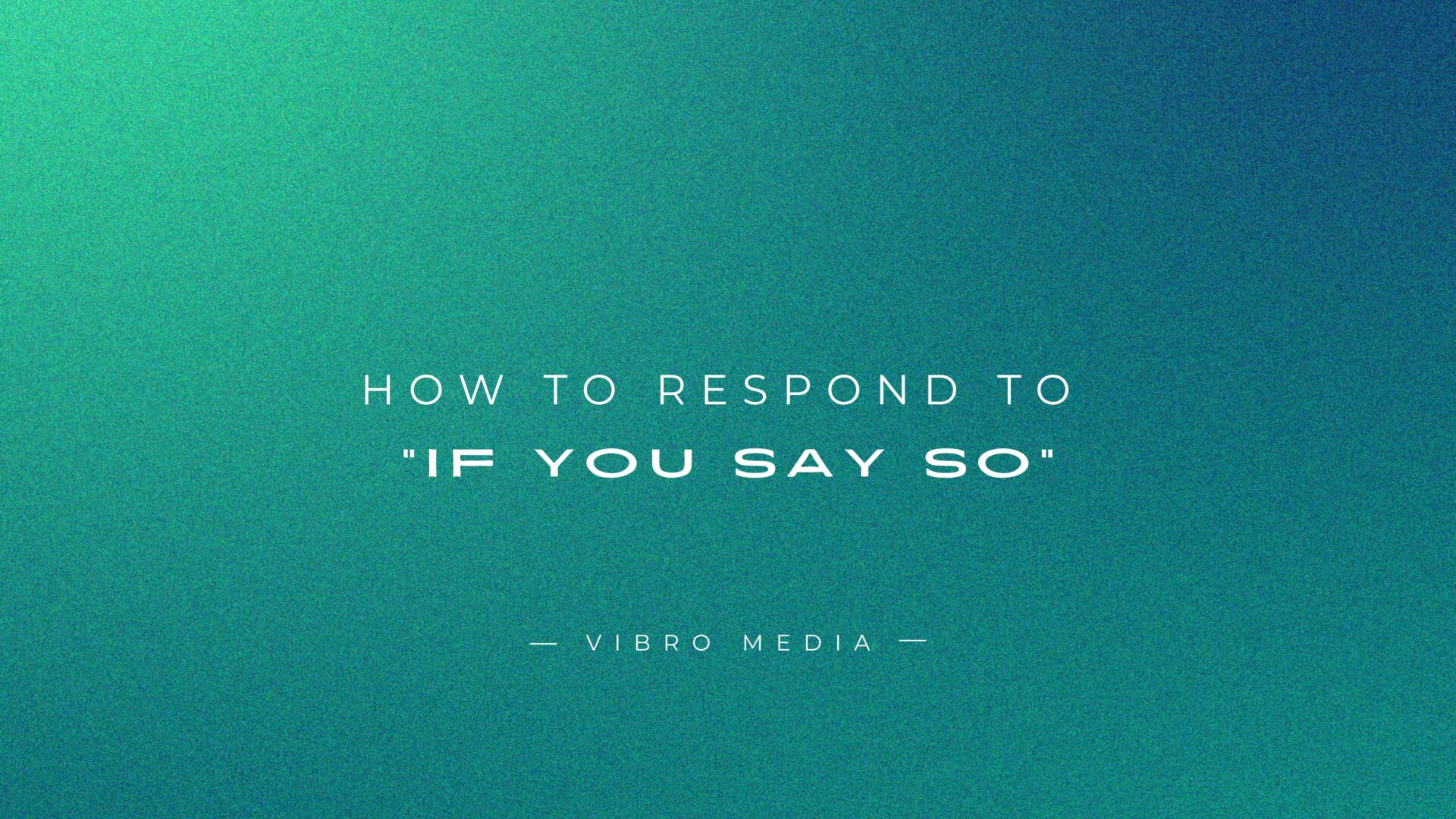Have you ever been in a conversation where the other person suddenly says, “If you say so”? It’s a phrase that can leave you perplexed, unsure if the person is agreeing with you, dismissing your point, or trying to avoid further discussion. The ambiguity behind “If You Say So” can make it challenging to respond appropriately, whether you’re in a casual chat or a more serious discussion.
In this article, we’ll break down the meaning of this common phrase, explore why it’s often confusing, and provide practical ways to respond confidently. We’ll also dive into the psychology behind it and share strategies to keep the conversation flowing smoothly.
Understanding the Phrase “If You Say So”
- The Different Meanings of “If You Say So”
The phrase “If You Say So” can carry different meanings depending on the speaker’s context, tone, and relationship. Sometimes, it can be a simple, neutral acknowledgment of your words. Other times, it may be loaded with sarcasm, doubt, or passive-aggression.
For example, a friend might say, “If you say so,” lightheartedly, meaning they trust your opinion. On the other hand, a colleague might use the same phrase to express skepticism without outright challenging you.
- Tone and Context: The Key to Interpretation
Tone and context are crucial when interpreting “If You Say So.” A warm, playful tone indicates that the person agrees with your point, even if they might not fully agree. However, a flat or cold tone can suggest that the person is disengaged or even frustrated. Paying attention to the surrounding conversation and the speaker’s body language can help you gauge the true meaning.

200+ Replies To “If You Say So”
Affirmative Agreement
- Yep, I see what you mean.
- If you say so!
- I’m on board with that.
- Got it, that makes sense.
- You’re right; I agree with you.
- Sure thing, if that’s how it is.
- I trust your judgment on this.
- You’ve got a point there.
- Sounds good to me.
- I’m with you on this one.
Neutral Responses
- Alright, if that’s what you think.
- Okay, I’ll go along with that.
- Fair enough.
- That’s one way to look at it.
- Got it, I hear you.
- Sure, if you say so.
- Alright then.
- Understood.
- Okay, that sounds fine.
- I see where you’re coming from.
Playful or Lighthearted Responses
- Alright, if you say so, Chief!
- Well, if you insist!
- You’re the boss, after all.
- Okay, I’ll take your word for it!
- If you say so, you must be right!
- Well, aren’t you the expert?
- Only because you said so!
- I guess you’ve got it all figured out!
- Alright, I’ll go along with your genius plan!
- Sure thing, Captain!
Sarcastic or Skeptical Responses
- Oh, really? If you say so.
- Right, because that makes total sense.
- Sure, if you say so. I’ll believe it when I see it.
- Okay, I guess you’re the expert here.
- Yeah, because that’s exactly how it works.
- Oh, absolutely. How could I doubt you?
- Well, if you say so, it must be true!
- I’m sure that’ll work out perfectly.
- If you say so, I’ll go with it.
- Sure, because you’re always so spot on.
Dismissive or Reluctant Responses
- If you say so, whatever.
- Okay, if that’s what you think.
- Fine, if that’s how you want to do it.
- Sure, if you insist.
- Alright, I’ll go with that.
- If you say so, it’s not a big deal.
- Alright then, if that’s what you want.
- Okay, if that’s your choice.
- Sure, if it means that much to you.
- If it makes you happy.
Questioning or Doubtful Responses
- Are you sure about that?
- Do you think so?
- What makes you say that?
- Please explain that.
- Is that how you see it?
- Are you positive that’s the case?
- What’s your reasoning behind that?
- How did you come to that conclusion?
- Is that the way to go?
- Can you clarify your point?
Polite but Disagreeing Responses
- I see your point, but I have a different perspective.
- I understand where you’re coming from, but I see it differently.
- That’s one way to look at it, but I think there’s another angle.
- I appreciate your viewpoint, but I don’t quite agree.
- I hear what you’re saying, but I have a different opinion.
- That’s an interesting take, but I’m not sure I agree.
- I can see why you think that, but I see it differently.
- I understand your point, but there might be another side to it.
- I see your perspective, but I have some reservations.
- That’s an option, but I would consider another approach.
Curious or Inquisitive Responses
- What led you to that conclusion?
- Can you tell me more about how you arrived at that?
- I’m interested—what’s your reasoning?
- How did you come to that decision?
- What’s your thought process behind this?
- Can you elaborate on why you think that?
- I’m curious: what makes you say so?
- What are the factors that led you to that view?
- Please explain your perspective.
- What’s your rationale for thinking that way?
Humorous Responses
- Oh, you’re the oracle of wisdom, I see!
- Well, you’ve got all the answers, don’t you?
- I trust you’re the guru on this one!
- Okay, I’ll follow your lead, oh, wise one!
- Sure, if you say so, I’ll go with the flow!
- Alright, I’ll let you be the captain here!
- If you say so, I’ll nod and agree!
- I guess I’ll follow your expert advice!
- Okay, I’ll take your word for it, just this once!
- If you say so, I’ll assume you’re a genius!
Indifferent Responses
- Alright, if that’s what you think.
- Okay, whatever you say.
- Sure, if you think so.
- I got it; it doesn’t matter to me.
- Fine by me.
- If that’s what you want, so be it.
- Okay, not a big deal.
- That works.
- Alright, I don’t have a strong opinion.
- Sure, if that’s how you see it.
Encouraging Responses
- If you believe that, then go for it!
- I’m sure you’ve got this all figured out.
- I support your decision!
- You know what you’re doing, so let’s do it!
- I’m behind you on this one.
- If you say so, then I trust your judgment.
- You’ve got this; I’m confident in your choice!
- I’m sure it will work out if you think it’s right.
- Go ahead with it; you know best.
- I’m sure you’ve got a great plan.
Confused Responses
- Please explain that.
- I’m not quite sure I follow. Could you clarify?
- I’m a bit confused—could you go over that again?
- That doesn’t quite make sense to me. Can you elaborate?
- I’m not sure I understand. What do you mean by that?
- Can you explain your reasoning? I’m a bit lost.
- I’m having trouble following up. What exactly do you mean?
- I’m confused about that. Could you explain further?
- I don’t quite get it. Can you help me understand?
- I’m a little unclear on this. What’s the reasoning?
Supportive Responses
- If you say so, I’m here to back you up.
- I support your decision. You’ve got this!
- Whatever you decide, I’m on your side.
- If that’s your call, I’m with you all the way.
- I trust your judgment completely.
- You’ve got my full support on this.
- If you think that’s best, I’m behind you.
- I’m with you. Go ahead and do it!
- I’m here for you, no matter what you decide.
- You have my backing. I believe in your choice.
Defensive Responses
- I’m just going with what you said, okay?
- I’m only following your lead here.
- I’m not saying it’s right or wrong, just going along.
- I’m sticking to what you suggested.
- That’s your plan, not mine.
- I agree; don’t blame me if it doesn’t work.
- I’m just following your instructions, nothing more.
- If you say so, but I’m just the messenger here.
- I’m just doing what you asked, nothing else.
- I’m only repeating what you said.
Sarcastic Compliment Responses
- Oh, of course, because you’re always right!
- Well, look at you, solving all the problems!
- Oh, brilliant idea, as always!
- I’m sure it’s perfect, just like your other plans!
- Of course, your genius always works!
- Naturally, your solution is flawless!
- Right, because you’re such a mastermind!
- Wow, that’s a fantastic idea—I never doubted you!
- Well, you’ve outdone yourself this time!
- Oh, you’re a real visionary!
Worried Responses
- I hope you’re right about this.
- I’m a bit concerned—are you sure this will work?
- I hope this turns out okay.
- If you say so, but I’m a bit anxious about it.
- I’m a little worried, but I’ll go along with it.
- I hope this decision is the right one.
- I’m not entirely convinced, but I’ll trust your judgment.
- I hope this doesn’t backfire.
- If you’re confident, I hope it works out.
- I’m crossing my fingers this works as planned.
Passive-Aggressive Responses
- Sure, if that’s what you think is best.
- If you say so.
- Fine, if that’s how you want to do it.
- Okay, if you insist on that approach.
- Alright, if that’s what you’re set on.
- Well, I suppose that’s one way to handle it.
- If you think you’ve got it all figured out.
- Sure, if you’re so sure about it.
- Okay, I’ll follow your lead, as usual.
- Alright then, if you’re so convinced.
Surprised Responses
- Oh, really? That’s not what I expected!
- Wow, I didn’t see that coming!
- I’m surprised you think that.
- Oh, I didn’t realize you felt that way!
- Well, that’s an unexpected twist!
- I’m shocked by your perspective!
- Really? That’s a surprise to me!
- I didn’t think you’d say that!
- Oh, that’s an interesting take!
- I’m surprised by your view on this.
Reluctant Agreement
- Okay, if you think so.
- I guess I’ll go along with that.
- Well, if you’re sure, I suppose.
- Alright, though, I’m not entirely convinced.
- Fine, if that’s what you want.
- If you say so, but I’m not thrilled about it.
- I’ll go with it, though I have my doubts.
- Alright, but I’m not entirely on board.
- Okay, if you think it’s the best option.
- If that’s your decision, I’ll accept it.
Joking Disbelief
- Oh, really? Is that the plan? Well, good luck!
- If you say so, I hope you’re not pulling my leg!
- Oh, come on! You’re kidding, right?
- Seriously? If you say so, but I’m not holding my breath!
- Alright, if you say so—this should be interesting!
- Oh, you’re full of surprises! I’ll believe it when I see it!
- If you say so, I’ll sit back and watch this unfold!
- Okay, I’m intrigued! Let’s see how this turns out!
- Really? What’s your big idea? Well, I’ll be watching!
- Oh, absolutely—if you say so, I’m all ears!
Common Situations Where You Might Hear “If You Say So”
- In Casual Conversations
In casual conversations with friends or family, “If You Say So” can be a way for someone to humor you or gently agree without delving too deep into the topic. It’s saying, “I trust your judgment,” without committing fully to the statement.
- In Professional Settings
Hearing “If You Say So” can be trickier in a work environment. It might come from a coworker who doesn’t want to engage in a debate or a superior who is subtly questioning your ideas. This phrase in a professional setting may indicate that the person isn’t entirely convinced but isn’t willing to argue, either.
- In Conflicts or Arguments
“If You Say So” can be a red flag during conflicts or disagreements. It’s often used to shut down the conversation without resolving the issue. The phrase might indicate that the person has given up trying to convince you or is avoiding further conflict.
Why “If You Say So” Can Be Confusing
- The Subtlety Behind the Words
The subtle nature of “If You Say So” makes it so confusing. Unlike a direct agreement or disagreement, this phrase exists in a gray area. It neither confirms nor denies the speaker’s stance, leaving you wondering what they truly think.
- Is It Agreement or Disagreement?
The ambiguity of the phrase can leave you second-guessing the person’s intent. Are they agreeing with you? Are they just tired of the conversation? The answer is often hidden in how the phrase is delivered and what the person says afterward (or doesn’t say).
How to Respond to “If You Say So”
- Stay Calm and Assess the Situation
When someone says “If You Say So,” it’s easy to feel frustrated or unsure. The best first step is to stay calm and assess the situation. Take a moment to consider the tone, context, and body language of the other person before reacting.
- Responding in a Casual Conversation
In a casual conversation, a lighthearted response can often diffuse any tension. For example, you could say, “Well, I do say so!” with a smile. This acknowledges their statement without creating further conflict and keeps the conversation friendly.
- Responding in a Professional Environment
In a professional setting, it’s important to remain diplomatic. A good response might be, “I appreciate your input. Let’s discuss this further if you have concerns.” This shows that you’re open to dialogue and aren’t shutting down their perspective.
- How to Address the Underlying Emotions
Sometimes, “If You Say So” is a sign of underlying emotions that must be addressed. If you sense frustration or doubt, it can be helpful to gently probe further by asking, “I feel like there’s more to this. Is there something on your mind?”
The Psychology Behind “If You Say So”
- Passive-Aggressive Tendencies
Sometimes, “If You Say So” can be a passive-aggressive remark. The speaker might feel resentful or frustrated but doesn’t want to express it directly. Understanding this helps you respond in a way that diffuses tension rather than escalating it.
- Avoidance of Conflict
Other times, the phrase may be used as an avoidance tactic. The speaker could be trying to prevent further conflict by agreeing superficially, even if they don’t genuinely agree. This can be a sign that the person is uncomfortable with confrontation.
Mistakes to Avoid When Responding to “If You Say So”
- Reacting with Frustration
It’s easy to get frustrated when you hear “If You Say So,” especially if it feels dismissive. However, reacting with anger or frustration can escalate the situation. Instead, try to stay calm and composed.
- Ignoring the Message
Another mistake is to ignore the message behind the phrase. If the person is trying to communicate doubt or discomfort, ignoring it can lead to unresolved issues. Acknowledge their words and gently explore what might happen beneath the surface.
- Misinterpreting the Intention
Lastly, avoid jumping to conclusions about the speaker’s intent. Sometimes, “If You Say So” is a neutral phrase with no hidden meaning. Give the person the benefit of the doubt before making assumptions.
The Power of Tone and Body Language in Your Response
- Using Positive Body Language
When responding to “If You Say So,” your body language can make a big difference. Open, positive body language, like maintaining eye contact and nodding, shows you’re engaged and open to communication.
- Matching Tone to Your Message
Your tone of voice can also influence how your response is received. A calm, friendly tone can help deescalate tension, while a sarcastic or harsh tone might worsen the situation.
How to Turn the Conversation Around After Hearing “If You Say So”
- Redirecting the Discussion
If “If You Say So” seems to signal the end of the conversation, you can redirect the discussion to keep it productive. For example, you could say, “I’d like to hear more about your thoughts. Can we talk about it?”
- Building a Bridge of Understanding
Building a bridge of understanding involves finding common ground and showing empathy. You might say, “I see where you’re coming from, and I’d love to understand your perspective better.”
What to Do When “If You Say So” Comes From Someone You Care About
- Handling Emotional Reactions
When someone you care about says, “If You Say So,” it can feel hurtful, especially if it sounds dismissive. In these cases, it’s important to handle your emotional reaction carefully. Take a deep breath and approach the conversation with empathy and openness.
- Encouraging Honest Communication
Encourage honest communication: “I want to ensure we’re both being heard. Can we talk about how you’re feeling?” This creates space for the other person to share their thoughts and feelings.
How “If You Say So” Reflects on the Speaker
- Is the Person Disengaged?
Sometimes, “If You Say So” can indicate that the speaker is disengaged from the conversation. They may need to be more energized or interested in continuing the discussion. Recognizing this can help you decide whether to press the issue or let it go.
- Are They Simply Agreeing to Move On?
In other cases, the person might use “If You Say So” to agree and move on. They may not see the point in continuing the discussion and prefer to end it there. If that’s the case, consider whether the topic is worth pursuing.
Encouraging a More Open Dialogue
- Asking for Clarification
One of the best ways to encourage more open dialogue is to ask for clarification. A simple “Can you tell me more about what you’re thinking?” invites the other person to share their thoughts without pressure.
- Expressing Your Feelings
It’s also important to express your feelings. If “If You Say So” feels dismissive, it’s okay to say, “There might be more we need to talk about. Can we discuss this further?”
How “If You Say So” Impacts Relationships
- Strains on Communication
When “If You Say So” becomes a regular part of communication, it can strain relationships. The phrase can make you feel unheard or dismissed, leading to frustration and resentment.
- How to Resolve Underlying Issues
It’s important to address the communication pattern directly to resolve underlying issues. Discuss how the phrase makes you feel and work together to find better ways to express agreement or disagreement.
Conclusion
In conclusion, knowing how to respond to “If you say so” can help you confidently steer conversations, whether opting for humor, sarcasm, or a thoughtful reply. With over 200 ideas to choose from, you can now turn this common expression into an opportunity for a memorable interaction. If you’re looking for more inspiration on how to navigate tricky social situations,
check out our guide on:
How do you answer “What’s New With You?” with 200+ creative replies here?
FAQs
Q. What does “If You Say So” really mean?
“If You Say So” can mean different things depending on the tone and context. It might indicate agreement, skepticism, or even passive-aggression. Pay attention to how it’s said to understand its true meaning.
Q. Is “If You Say So” always a negative response?
Only sometimes. It is sometimes acknowledging what someone has said in a neutral or lighthearted way. However, context is important and can also be used sarcastically or dismissively.
Q. How should I respond to “If You Say So” in a professional setting?
In a professional setting, staying composed and open to further discussion is best. You might respond with something like, “I appreciate your input. Let’s talk more if you have any concerns.”
Q. What can I do if “If You Say So” feels dismissive?
If the phrase feels dismissive, try to probe further gentler. You can ask, “Is there something more we should discuss?” This opens the door for a more in-depth conversation.
Q. How do I encourage more open communication after hearing “If You Say So”?
Encourage open communication by asking for clarification and expressing your feelings. Let the other person know you want to hear their perspective and resolve any underlying issues.











1 thought on “How to Respond to “If You Say So” : 200+ Reply Ideas”